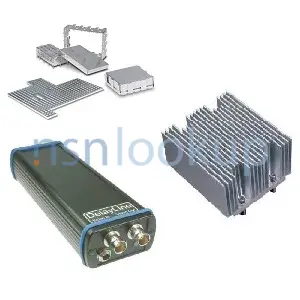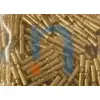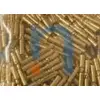Electrical Contact
Item Name Code (INC) 00443
 |
An item consisting of an electrically conductive material designed to furnish a surface which will physically and electrically meet another conducting surface for the purpose of transferring electrical energy and/or opening and closing circuits. Includes moving contacts which make and/or slide over stationary contacts or other stationary conductive material to a resulting fixed position. Excludes items which are used in conjunction with continually moving surfaces or which make contact by gripping action of the contact surfaces. See also CLIP, ELECTRICAL; CLAMP, ELECTRICAL; BRUSH, ELECTRICAL CONTACT; PLUG, TIP; and JACK, TIP.
 Additional Information for Electrical Contact
Additional Information for Electrical Contact
Electrical contacts are components used in electrical and electronic equipment to establish and maintain electrical connections. They are typically made of conductive materials such as copper, silver, or gold, which have good electrical conductivity.
Electrical contacts are designed to provide a reliable and low-resistance connection between two conductive surfaces. They can be used in various applications, including switches, relays, connectors, circuit breakers, and other electrical devices.
The main function of electrical contacts is to allow the flow of electrical current between two conductive parts while minimizing resistance and preventing excessive heat generation. They are often designed to withstand high currents and voltages, as well as mechanical wear and environmental conditions.
There are different types of electrical contacts available, including:
1. Solid Contacts: These contacts are made of a single piece of conductive material and provide a direct electrical connection between two surfaces.
2. Spring Contacts: These contacts use a spring mechanism to maintain electrical contact between two surfaces. They are commonly used in connectors and switches where repeated mating and unmating is required.
3. Sliding Contacts: These contacts are designed to allow relative motion between two surfaces while maintaining electrical contact. They are often used in potentiometers and variable resistors.
4. Welded Contacts: These contacts are created by welding two conductive surfaces together. They provide a permanent and reliable electrical connection.
5. Bimetallic Contacts: These contacts are made of two different metals with different coefficients of thermal expansion. They are used in temperature-sensitive applications, such as thermal switches and overload relays.
Overall, electrical contacts play a crucial role in ensuring the proper functioning of electrical and electronic equipment by providing a reliable and low-resistance electrical connection.
 Related Item Names for INC 00443 Electrical Contact
Related Item Names for INC 00443 Electrical Contact
 NATO Stock Numbers with Item Name 00443 Electrical Contact Page 1 of 80
NATO Stock Numbers with Item Name 00443 Electrical Contact Page 1 of 80
- 010242004
- 12259041-3
- RNCC: 1 | RNVC: 2
- 584R721H04
- RNCC: 3 | RNVC: 2
- 370-0033-080
- RNCC: 5 | RNVC: 2
- 044052D
- RNCC: 5 | RNVC: 2
- B91286
- RNCC: 5 | RNVC: 2
- 030-2064-010
- RNCC: 5 | RNVC: 2
- C8419-1
- RNCC: 5 | RNVC: 2
- 030-2064-010
- RNCC: 5 | RNVC: 2
- 2557831140
- RNCC: 5 | RNVC: 2
- 44052D
- RNCC: 5 | RNVC: 2
- 003684852
- 10-35527
- RNCC: 3 | RNVC: 2
- 7716522
- RNCC: 5 | RNVC: 2
- 5990003684852
- RNCC: 5 | RNVC: 9
- 5999003684852
- RNCC: 5 | RNVC: 9
- 5990003684852
- RNCC: 6 | RNVC: 9
- 007716527
- 7716527
- RNCC: 3 | RNVC: 2
- 10-35532
- RNCC: 3 | RNVC: 2
- 10-035532-000
- RNCC: 5 | RNVC: 2
- 5999007716527
- RNCC: 5 | RNVC: 9
- 004858955
- 7716521
- RNCC: 3 | RNVC: 2
- 7414201
- RNCC: 5 | RNVC: 2
- 5293286
- RNCC: 5 | RNVC: 2
- 3KP86
- RNCC: 5 | RNVC: 2
- 10-597125-12P
- RNCC: 5 | RNVC: 2
- 5293286
- RNCC: 5 | RNVC: 9
- 5999004858955
- RNCC: 5 | RNVC: 9
- 3KP86
- RNCC: 5 | RNVC: 9
- 10-33646
- RNCC: 5 | RNVC: 9
- 004858954
- 7716520
- RNCC: 3 | RNVC: 2
- 7716520
- RNCC: 5 | RNVC: 2
- 7716520
- RNCC: 5 | RNVC: 2
- C-3014-9012-C105
- RNCC: 5 | RNVC: 2
- 2HE847
- RNCC: 5 | RNVC: 2
- 7716520
- RNCC: 5 | RNVC: 2
- 10-33644
- RNCC: 5 | RNVC: 2
- 7716520
- RNCC: 5 | RNVC: 9
- 5999004858954
- RNCC: 5 | RNVC: 9
- 2HE847
- RNCC: 5 | RNVC: 9
- 002049891
- S919884
- RNCC: 3 | RNVC: 2
- S919884
- RNCC: 5 | RNVC: 9
- 5999002049891
- RNCC: 6 | RNVC: 9
- 016677871
- 3SU1400-1AA10-1CAO
- RNCC: 3 | RNVC: 2
- 3SU1400-1AA10-1CA0
- RNCC: 3 | RNVC: 2
- 3SU1400-1AA10-1CAO
- RNCC: 5 | RNVC: 2
- 8001103
- RNCC: 5 | RNVC: 2
- 18254 ITEM 16
- RNCC: 5 | RNVC: 2
- 3SU14001AA101CA0
- RNCC: 5 | RNVC: 2
- 225L79970-M03
- RNCC: 5 | RNVC: 2
- 76-20844
- RNCC: 5 | RNVC: 9
- 3SU1400-1AA10-1CAO
- RNCC: 5 | RNVC: 9
- 18254
- RNCC: D | RNVC: 9
- 005882373
- V6712024PC1
- RNCC: 3 | RNVC: 2
- WW8259361LIST2ITEM2
- RNCC: 3 | RNVC: 2
- 228-62-01341LIST5ITEM6
- RNCC: 3 | RNVC: 2
- WW8259202ITEM4SH2
- RNCC: 5 | RNVC: 2
- 292-62-01414LIST5ITEM1
- RNCC: 5 | RNVC: 2
- WW8259300LIST4ITEM15
- RNCC: 5 | RNVC: 2
- WW8677697ITEM6SH3
- RNCC: 5 | RNVC: 2
- 7023F23LIST4ITEM15
- RNCC: 5 | RNVC: 2
- 313-62-01300ALT3LIST4ITEM20
- RNCC: 5 | RNVC: 2
- 212-62-01304LIST5ITEM6
- RNCC: 5 | RNVC: 2
- 992510112
- C585-6
- RNCC: 3 | RNVC: 2
- 003544867 SHEET 10
- RNCC: 5 | RNVC: 1
- 003544867 SHEET 6
- RNCC: 5 | RNVC: 1
- 003544867 SHEET 8
- RNCC: 5 | RNVC: 1
- R 2216
- RNCC: 5 | RNVC: 1
- R 327
- RNCC: 5 | RNVC: 1
- R 328
- RNCC: 5 | RNVC: 1
- XL3 842 7704
- RNCC: 5 | RNVC: 1
- XL3 844 7706
- RNCC: 5 | RNVC: 1
- XL3-840-7702
- RNCC: 5 | RNVC: 1
- 002588935
- K1-6505-1001162ALT4PC11
- RNCC: 3 | RNVC: 2
- 564-3101-937728LINE252
- RNCC: 5 | RNVC: 2
- 564-6505-937716ALT4PC11
- RNCC: 5 | RNVC: 2
- 571-6202-1301776REVALINE41
- RNCC: 5 | RNVC: 2
- 571-6505-1301647REVAPC11
- RNCC: 5 | RNVC: 2
- 571-6505-1301647REVAPC17
- RNCC: 5 | RNVC: 2
- 575-6202-1444156REVBLINE516
- RNCC: 5 | RNVC: 2
- 575-6505-1443388REVAPC11
- RNCC: 5 | RNVC: 2
- 6505-1001162PC11
- RNCC: 5 | RNVC: 2
- K1-3101-1001284ALT2LINE272
- RNCC: 5 | RNVC: 2
- 011129678
- 826364A00
- RNCC: 3 | RNVC: 2
- 82636HA CE 353
- RNCC: 5 | RNVC: 9
- 826364A
- RNCC: 5 | RNVC: 9
- 002049974
- 3767-23REVAPC15
- RNCC: 3 | RNVC: 2
- 313-6505-231712PC14
- RNCC: 5 | RNVC: 2
- 340-6000-1002475ALT1LINE129
- RNCC: 5 | RNVC: 2
- 347-6505-839142ALT2PC14
- RNCC: 5 | RNVC: 2
- 563-6505-933897ALT3PC15
- RNCC: 5 | RNVC: 2
- 563-6505-933920ALT1PC9
- RNCC: 5 | RNVC: 2
- 564-3101-937728LINE244
- RNCC: 5 | RNVC: 2
- 564-6505-937725ALT4PC15
- RNCC: 5 | RNVC: 2
- 569-6505-1192122ALTAPC9
- RNCC: 5 | RNVC: 2
- 571-6202-1301776REVBLINE427
- RNCC: 5 | RNVC: 2
- 000301953
- S1308251
- RNCC: 3 | RNVC: 2
- 98123-6307-551386PC1G
- RNCC: 5 | RNVC: 2
- 98223-6307-587676PC1G
- RNCC: 5 | RNVC: 2
- 98223-6307-587680PC1G
- RNCC: 5 | RNVC: 2
- 98223-6307-587671PC1G
- RNCC: 5 | RNVC: 2
- K2-6303-1089917PC3D
- RNCC: 5 | RNVC: 2
- 98223-6307-587670PC1G
- RNCC: 5 | RNVC: 2
- 98723-6307-587672PCSP1G
- RNCC: 5 | RNVC: 2
- 98323-6307-587673PC19
- RNCC: 5 | RNVC: 2
- 98123-6307-587675PCSP1G
- RNCC: 5 | RNVC: 2
- 218891251
- 10070120S
- RNCC: 3 | RNVC: 2
- 111-000508
- RNCC: 5 | RNVC: 2
- 251157570
- 249-5052-000
- RNCC: 3 | RNVC: 2
- 995242757
- E9369/3
- RNCC: 3 | RNVC: 2
- E9369-3
- RNCC: 5 | RNVC: 1
- 0634-201329
- RNCC: 6 | RNVC: 9
- 0634-524-2757
- RNCC: 6 | RNVC: 9
- 015963110
- GMD-32-24VDC
- RNCC: 3 | RNVC: 2
- DY-HP-02-0040
- RNCC: 5 | RNVC: 2
- GMD32-24VDC
- RNCC: 5 | RNVC: 2
- 016674862
- 3SU1400-1AA10-1BA0
- RNCC: 3 | RNVC: 2
- 3SU1400-1AA10-1BA0
- RNCC: 5 | RNVC: 2
- 8001102
- RNCC: 5 | RNVC: 2
- 3SU1400-1AA10-1BA0
- RNCC: 5 | RNVC: 2
- 76-20843
- RNCC: 5 | RNVC: 2
- 3SU1400-1AA10-1BA0
- RNCC: 5 | RNVC: 2
- 3SU14001AA101BA0
- RNCC: 5 | RNVC: 2
- 1118911
- RNCC: 5 | RNVC: 2
- 70107893
- RNCC: 5 | RNVC: 2
- 225L79969-M03
- RNCC: 5 | RNVC: 2
- 996474134
- 030-7879-000
- RNCC: 3 | RNVC: 2
- 9550122250
- RNCC: 5 | RNVC: 2
- 302-493-302-0
- RNCC: 5 | RNVC: 2
- 620-858-069-0
- RNCC: 5 | RNVC: 2
- 754-4-30403
- RNCC: 5 | RNVC: 2
- 8950-4100B
- RNCC: 6 | RNVC: 9
- 016992998
- SAE-AS39029/44
- RNCC: 3 | RNVC: 1
- AS39029/44-291
- RNCC: 3 | RNVC: 2
- 915-0808-099
- RNCC: 5 | RNVC: 2
- 213-8897119 ITEM 86
- RNCC: C | RNVC: 1
- 002171006
- 26493-23-1
- RNCC: 3 | RNVC: 2
- 26493-23-11
- RNCC: 3 | RNVC: 2
- M5114400REVAITEM17D
- RNCC: 5 | RNVC: 2
- M5114400REVAITEM19C
- RNCC: 5 | RNVC: 2
- M5114404REVDITEM6C
- RNCC: 5 | RNVC: 2
- M5114407ABREVBITEM17D
- RNCC: 5 | RNVC: 2
- 312-6201-981666ITEM5
- RNCC: 5 | RNVC: 2
- 313-6201-60603ALT4PC32
- RNCC: 5 | RNVC: 2
- 340-6502-1002317ALT6PC2649323-1
- RNCC: 5 | RNVC: 2
- 3402-3111567
- RNCC: 5 | RNVC: 2
- 993509058
- MPS16
- RNCC: 3 | RNVC: 2




